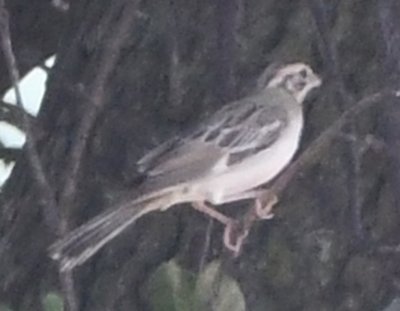
DSC_7527b.jpgNear Dover, OK, we stopped for some birds near cattle along the highway, including this Lark Sparrow. |
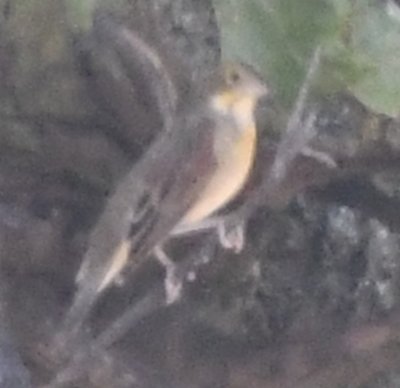
DSC_7529b.jpgMost of the markings for this bird look like a Dickcissel to me.
BD: Dickcissel is correct I think. The one thing that is a little off from the Sibley illustrations is that this bird has a lot of yellow color for a female but also lacks the black bib of the adult male. A hatch year fall male would probably look like this -- Sibley doesn't illustrate that particular version. |

DSC_7537b.jpgCowbirds |
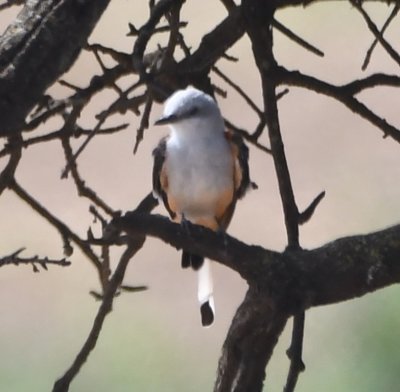
DSC_7546b.jpgThis Scissor-tailed Flycatcher looks like he may only have one long tail feather. |

DSC_7552b.jpgLark Sparrow |

DSC_7560b.jpgWe turned W to look for some Black-bellied Whistling Ducks, but found this Great Egret instead. |
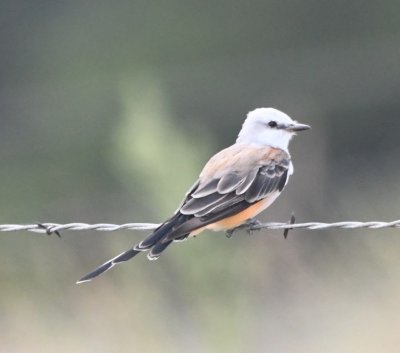
DSC_7563b.jpgScissor-tailed Flycatcher |

DSC_7565b.jpgBaird's Sandpipers
The wing tips look like they extend a little past the tail and the legs are dark.
BD: Agree those are Baird's. That particular brown color on the breast and elsewhere is unique to them, lacks any rufous tone and looks golden in good light, sort of like an oil stain in bad light. The black centers on the scapular feathers are more or less symmetrical, not pointed like arrowheads and not anchor-shaped. The long wings give the whole bird a long shape. From the front they look very short and broad, oval in cross-section. |

DSC_7573b.jpgLeast Sandpiper
Tail and wings about the same length, small sandpiper, legs may not be as dark as they appear in the photo (see other photos).
BD: The plumage colors on the back this bird are a good match to Sibley's juvenile Least, i.e. the different courses of rufous or white-edged feathers and the large, black, unpointed central spots. With the other characters you noted, Least is a good call. |
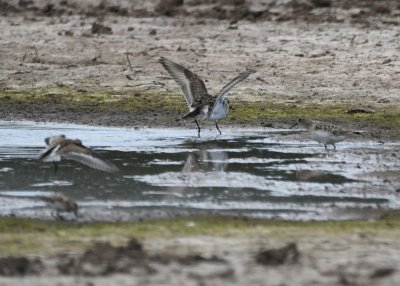
DSC_7581b.jpgWing pattern looks similar to Baird's Sandpiper in Sibley.
BD: Agree the bird in the background with wings spread is a Baird's (one of the birds of 565?), As you noted, the wing lacks a really distinct white wing stripe. The bird with wings spread in the foreground is a Least. The bird is smaller but also has a relatively dull wing pattern, more white in the tail. The view here obscures the difference in wing shape, Least short and rounded, Baird's long and pointed. |

DSC_7585b.jpgLeast Sandpiper in L foreground
BD: Juvenile Least with back plumage pattern very similar to bird of 573. Note that the head and breast are almost uniformly dark which are common look for Least. |

DSC_7587b.jpg |

DSC_7588b.jpgBaird's Sandpiper
BD: Yes, Baird's IMO. Note the shade of brown on the throat matches the previously identified birds as does the coloration of the primaries.
|

DSC_7589b.jpgBaird's Sandpiper
BD: the shape of the black centers on the scapulars suits Baird's better than most other sandpipers except perhaps for Least. |

DSC_7609b.jpgKilldeer |

DSC_7615b.jpgKilldeer |
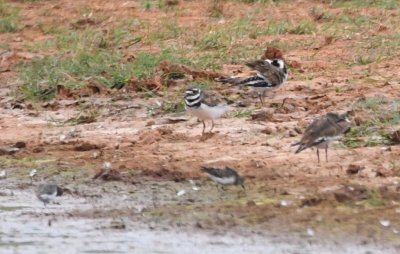
DSC_7623b.jpgLeast Sandpipers in the foreground; Killdeer in back
BD: Juvenile Least on right. Adult Least on left, probably the bird of 637. |

DSC_7624b.jpgBD: three Least along the shoreline and a Baird's (note larger size, long wings) in the water. |
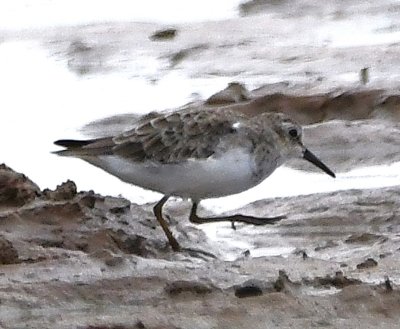
DSC_7637b.jpgLeast Sandpiper
This small sandpiper has possibly yellow legs with wingtips not extending past tail.
BD: Adult Least in winter plumage. Note the overall relatively dark gray look of the bird, the relatively wide black central feather markings, the leg color, the bill shape, and the very long toes. The long toes of Least allow it to forage in a different posture, more crouched with little down angle to the back, compared with most other sandpipers with relatively short bills. Can sort of tell the leg color is not black. |

DSC_7638b.jpgLeast Sandpiper? |

DSC_7643b.jpgGoing back E toward the N-S highway, we saw the Great Egret again and a Great Blue Heron in the background. |

DSC_7644b.jpgGreat Blue Heron |

DSC_7646b.jpgFarther away, sitting on a fence post, was this hawk. Red-tailed? |

DSC_7650b.jpgAnd on a wire along the road, we found a House Sparrow. |

DSC_7658b.jpgAfter driving up and down Highway 81 for a while, looking for a Common Black Hawk, we continued N, then jogged E and N again where we saw this Cooper's Hawk on a fence post alongside the road. |

DSC_7663b.jpgCooper's Hawk |

DSC_7669b.jpgCooper's Hawk |

DSC_7672b.jpgCooper's Hawk |

DSC_7682b.jpgWe eventually found the sod farm where Buff-breasted Sandpipers had been reported. Our first bird at this location was this Eastern Meadowlark. |

DSC_7684b.jpgKilldeer |

DSC_7770b.jpgUpland Sandpiper
This bird has a longer bill with a dark tip characteristic of UPSA and not Buff-breasted Sandpiper. |

DSC_7775b.jpgKilldeer |

DSC_7779b.jpgMourning Dove |











